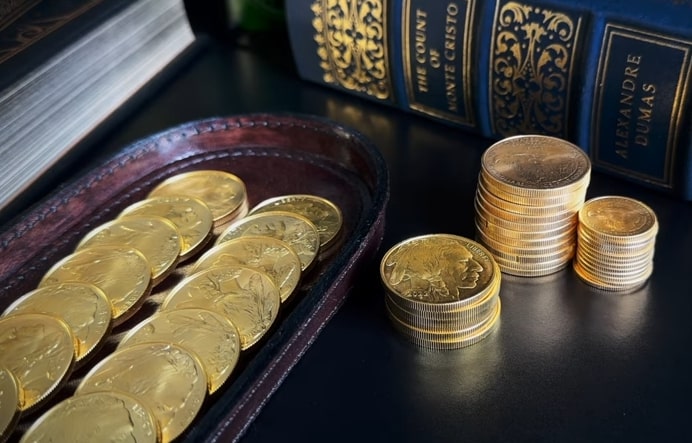
Gold has long been recognized as a valuable and stable investment option, particularly during uncertain economic times. Investing in gold provides diversification and acts as a hedge against inflation. However, it is crucial to approach gold investments with careful consideration and awareness of the safest avenues available. In this blog post, we will explore the safest ways to invest in gold, focusing on options that offer security, liquidity, and ease of management.
1. Physical Gold:
Investing in physical gold involves purchasing gold bullion or coins. While this method provides direct ownership of the precious metal, it also requires careful storage and insurance considerations. Here are some safe practices:
a. Certified Dealers: When purchasing physical gold, it is essential to transact with reputable and certified dealers. Look for dealers who are members of well-established industry associations and have a track record of reliable service.
b. Assay Certification: Ensure that the gold you purchase is accompanied by an assay certificate verifying its authenticity, weight, and purity. This certification adds an extra layer of security and protects you from counterfeit gold.
c. Secure Storage: Safeguarding your physical gold is crucial. Consider utilizing a professional vaulting service or a safe deposit box in a reputable bank. Insurance coverage should also be considered to protect against loss or theft.
d. Gold IRA: Gold IRAs are retirement accounts that are allowed to invest in physical gold, silver, platinum, and palladium. As the world descends into financial chaos, more investors are wanting to know how to move 401k to gold without penalty. Well, the key to doing this transaction safely is to pick an experienced gold IRA provider.
2. Gold Exchange-Traded Funds (ETFs):
Gold ETFs are investment funds that trade on stock exchanges, offering investors exposure to the price of gold without the need for physical ownership. Here’s why gold ETFs can be a safe option:
a. Transparency: ETFs provide transparency in terms of gold holdings and their value. Regular reporting ensures that investors have a clear understanding of the underlying assets.
b. Liquidity: Gold ETFs offer high liquidity, allowing investors to buy or sell shares on the stock exchange at any time during trading hours. This flexibility provides an additional layer of safety by allowing quick access to your investment.
c. Diversification: ETFs typically hold a diversified portfolio of gold, reducing the risk associated with investing in a single gold product or bar.
3. Gold Mining Stocks:
Investing in gold mining stocks provides exposure to the gold industry while avoiding the complexities of physical gold ownership. Consider the following points when investing in gold mining stocks:
a. Research and Analysis: Thoroughly research the mining companies you intend to invest in, considering factors such as management quality, financial stability, and production track record. Diversifying investments across multiple companies can mitigate individual stock risks.
b. Mining Index Funds: Investing in a mining index fund spreads the risk across multiple mining companies. This approach offers diversification and reduces the impact of individual stock performance on your investment.
c. Market Conditions: Understand that gold mining stocks are subject to market risks, including commodity price volatility and geopolitical factors. Staying updated on industry news and trends is vital for making informed investment decisions.
4. Gold Mutual Funds:
Gold mutual funds pool investors’ money to invest in a diversified portfolio of gold-related assets. Here’s why gold mutual funds can be a safe choice:
a. Professional Management: Gold mutual funds are managed by experienced professionals who have in-depth knowledge of the gold market. Their expertise can help navigate market fluctuations and optimize returns.
b. Diversification: By investing in a mutual fund, you gain exposure to a diversified portfolio of gold-related assets, reducing the risk associated with individual stocks.
c. Lower Investment Threshold: Mutual funds typically have lower investment thresholds compared to other gold investment options, allowing broader accessibility to investors.
Understanding How Gold is Taxed
Investing in gold offers a hedge against inflation and diversification within an investment portfolio. However, it is essential to understand the tax implications associated with gold investments to make informed decisions and optimize returns. In this blog post, we will delve into the various tax considerations that come into play when investing in gold.
1. Capital Gains Tax:
One of the primary tax implications of investing in gold is the treatment of capital gains. When you sell your gold investment at a higher price than your purchase price, you realize a capital gain. Here’s what you need to know:
a. Short-term vs. Long-term: The duration of your gold investment determines the tax rate on capital gains. If you hold the investment for one year or less, it is considered a short-term capital gain and is taxed at your ordinary income tax rate. Holding the investment for more than one year qualifies it as a long-term capital gain, which is subject to the applicable long-term capital gains tax rate.
b. Tax Rates: Long-term capital gains tax rates are typically lower than ordinary income tax rates, ranging from 0% to 20% based on your taxable income and filing status. Short-term capital gains are taxed at your marginal income tax rate.
c. Tax Losses: If your gold investment incurs a loss, you may be able to offset it against other capital gains or deduct it against your ordinary income, subject to specific tax regulations and limitations.
2. Gold-backed ETFs and Mutual Funds:
Investing in gold-backed exchange-traded funds (ETFs) and mutual funds brings unique tax considerations. Here’s what you should know:
a. Creation and Redemption: Gold ETFs and mutual funds are structured differently from direct gold ownership. When you buy or sell shares of gold-backed ETFs or mutual funds, there is no direct sale of gold. Instead, you transact with authorized participants who create or redeem shares in-kind with the underlying gold. As an investor, you are not personally liable for the tax consequences of these creations or redemptions.
b. Tax Efficiency: Gold-backed ETFs and mutual funds are designed to be tax-efficient investment vehicles. They aim to minimize taxable events within the fund, such as reducing capital gains distributions to shareholders.
3. Inherited Gold:
In the case of inherited gold, specific tax rules apply. Here are the key points to consider:
a. Step-up in Basis: When you inherit gold, the cost basis of the gold is adjusted to its fair market value at the time of inheritance. This step-up in basis can minimize the capital gains tax liability if you decide to sell the inherited gold.
b. Estate Taxes: Depending on the value of the estate, inheritance of gold may be subject to estate taxes. Estate tax regulations vary by jurisdiction, so it is advisable to consult with an estate planning professional to understand the implications.
4. Reporting Requirements:
When investing in gold, it is crucial to fulfill your reporting obligations. Here are a few key reporting requirements:
a. IRS Form 8949: Any capital gains or losses from the sale of gold must be reported on IRS Form 8949 and included in your annual tax return.
b. Foreign Accounts: If you hold gold in foreign accounts, additional reporting requirements may apply, such as the Foreign Account Tax Compliance Act (FATCA) for U.S. taxpayers. Be aware of the reporting obligations related to foreign assets to avoid penalties.
Safest Ways to Invest in Gold Mining Stocks
Gold has long been considered a safe-haven asset, prized for its ability to retain value even during economic downturns. Investing in gold stocks allows individuals to tap into the potential gains of the precious metal while benefiting from the growth prospects of mining companies. However, like any investment, gold stocks come with risks. In this article, we will explore the safest ways to invest in gold stocks, offering insights into strategies, risk management, and considerations for potential investors.
Educate Yourself:
Before delving into the world of gold stocks, it’s crucial to educate yourself about the market, industry trends, and the factors influencing gold prices. Understanding the supply-demand dynamics, geopolitical influences, and macroeconomic factors can help you make informed decisions.
Diversification:
Diversification is a fundamental principle of investing that helps mitigate risks. Instead of concentrating all your funds in a single gold stock, consider diversifying your portfolio by investing in multiple gold mining companies. This strategy spreads risk and reduces the impact of poor performance by one company.
Research Gold Mining Companies:
Not all gold mining companies are equal in terms of financial stability, management quality, and growth potential. Conduct thorough research on the companies you’re considering, analyzing their financial statements, production efficiency, exploration projects, and management track record. Look for companies like Sun Ridge Gold with a history of consistent performance and prudent financial management.
Consider ETFs and Mutual Funds:
Exchange-Traded Funds (ETFs) and mutual funds offer a way to invest in a diversified basket of gold stocks. These funds are managed by professionals who choose a mix of gold mining companies, reducing the risk associated with individual stocks. Popular gold-focused ETFs include SPDR Gold Shares (GLD) and VanEck Vectors Gold Miners ETF (GDX – https://www.vaneck.com/us/en/investments/gold-miners-etf-gdx/overview/).
Risk Management:
Investing in gold stocks comes with inherent risks, including commodity price volatility and company-specific risks. Set a clear risk tolerance and avoid investing more than you can afford to lose. Utilize stop-loss orders to automatically sell stocks if they fall below a certain price, limiting potential losses.
Monitor Global Economic Trends:
Gold prices are often influenced by global economic conditions. Keep an eye on economic indicators, interest rates, inflation, and geopolitical tensions. These factors can impact gold prices and, consequently, the performance of gold stocks.
Long-Term Perspective:
Gold stocks, like any investment, can experience short-term fluctuations. It’s important to maintain a long-term perspective, focusing on the overall growth potential of the gold industry rather than getting caught up in short-term market movements.
Stay Informed:
Stay updated with industry news, company developments, and market trends. Regularly review your investment portfolio and adjust your strategy as needed based on new information.
Consult Financial Advisors:
If you’re unsure about investing in gold stocks, consider consulting with a financial advisor. Their expertise can help you make well-informed decisions aligned with your financial goals and risk tolerance.
Avoid Speculative Behavior:
Investing in gold stocks should be approached with a goal of stable, long-term growth rather than short-term speculation. Avoid making impulsive decisions based on market noise or rumors.
Investing in gold stocks can be a prudent way to gain exposure to the potential benefits of gold while benefiting from the growth prospects of mining companies. To ensure the safest possible investment, educate yourself about the market, diversify your portfolio, research companies, consider ETFs and mutual funds, manage risks, and maintain a long-term perspective. By following these strategies and staying informed, you can navigate the world of gold stocks with greater confidence.
Conclusion:
Investing in gold can provide stability and protection against economic uncertainties. By considering the safest ways to invest in gold, such as physical gold, gold ETFs, gold mining stocks, and gold mutual funds, investors can make informed decisions aligned with their risk tolerance and financial goals. Remember to conduct thorough research, diversify investments, and consult with financial professionals when necessary to ensure a secure and successful gold investment strategy.



